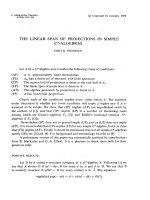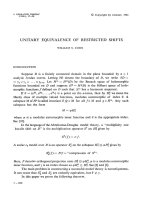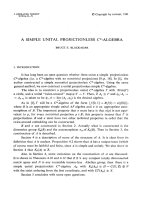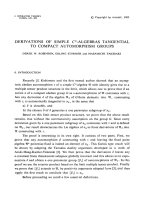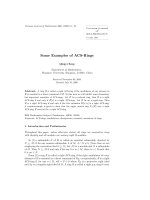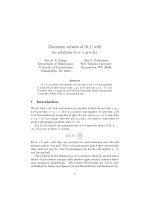Báo cáo toán học: "Maximum Cardinality 1-restricted Simple 2-matchings" pdf
Bạn đang xem bản rút gọn của tài liệu. Xem và tải ngay bản đầy đủ của tài liệu tại đây (138.23 KB, 13 trang )
Maximum Cardinality 1-restricted Simple 2-matchings
∗
David Hartvigsen
University of Notre Dame
Notre Dame, IN 46556-5646
Submitted: Mar 19, 2007; Accepted: Oct 14, 2007; Published: Nov 5, 2007
Mathematics Subject Classification: 05C70, 05C38, 90C27
Abstract
A simple 2-matching in a graph is a subgraph all of whose nodes have degree 1
or 2. A simple 2-matching is called k-restricted if every connected component has
> k edges. We consider the problem of finding a k-restricted simple 2-matching
with a maximum number of edges, which is a relaxation of the problem of finding
a Hamilton cycle in a graph. Our main result is a min-max theorem for the max-
imum number of edges in a 1-restricted simple 2-matching. We prove this result
constructively by presenting a polynomial time algorithm for finding a 1-restricted
simple 2-matching with a maximum number of edges.
Keywords: matchings, Hamilton cycle
1 Introduction
All graphs considered in this paper are undirected with no parallel edges or loops. A simple
2-matching in a graph is a subgraph all of whose nodes have degree 1 or 2. (For the sake
of brevity, we henceforth drop the adjective simple.) Hence the connected components of
a 2-matching are paths and cycles. A well-studied problem in the literature is to find a 2-
matching in a graph with a maximum number of edges, a so-called maximum 2-matching.
A polynomial time algorithm, Tutte-type theorem and Tutte-Berge-type theorem are
known for this problem, among many other things (see [19] for an excellent survey). In
this paper we present analogous results for a restricted version of this problem, which we
describe next.
A k-restricted 2-matching is a 2-matching such that each connected component has
> k edges. The k-restricted 2-matching problem is to find a k-restricted 2-matching with
∗
An extended abstract (without proofs) of an earlier version of this paper appeared in [10]. The main
theorem in the current paper, a min-max theorem for the maximum number of edges in a 1-restricted
simple 2-matching, did not appear in [10].
the electronic journal of combinatorics 14 (2007), #R73 1
a maximum number of edges, which we call a maximum k-restricted 2-matching. Hence
the 0-restricted 2-matching problem is to find a maximum 2-matching and the 1-restricted
2-matching problem is to find a maximum 2-matching that contains no “isolated edges.”
Note that the k-restricted problem is a relaxation of the problem of finding a Hamilton
cycle in a graph due to the following observation: A graph G with n nodes has a Hamilton
cycle if and only if G has a k-restricted 2-matching with n edges, where k > n/2.
Before describing our main results, let us introduce some notation. Let ν
k
(G) denote
the number of edges in a maximum k-restricted 2-matching for a graph G. Note that
n ≥ ν
0
(G) ≥ ν
1
(G) ≥ ν
2
(G) ≥ · · · .
Our main result is a min-max formula for ν
1
(G). An analogous result for ν
0
(G) appears
in [19] and is proved using a construction of Tutte [22] and the Tutte-Berge theorem [2];
the Tutte-Berge theorem is an analogous result for classical matchings (hence we refer to
such results as “Tutte-Berge-type”). In addition, we present a formula for ν
0
(G) − ν
1
(G)
and we characterize those graphs G for which ν
0
(G) = ν
1
(G). (These two additional
results were stated without proof in [10].) An analogous result, characterizing the graphs
for which n = ν
0
(G), was obtained by Belck [1] and Gallai [9], and, in a more general
form, by Tutte [21]; an analogous result for classical matchings was also proved by Tutte
[20]) (hence we refer to such theorems as “Tutte-type”).
In this paper, we also present a polynomial time algorithm for the 1-restricted 2-
matching problem. The algorithm’s validity and our main result are proved simultane-
ously. The algorithm is a modified and simplified version of an algorithm that appeared
in [13] for a related problem (see discussion below). An interesting feature of the algo-
rithm is that it starts with a maximum 2-matching and modifies it to obtain a maximum
1-restricted 2-matching. As a corollary to the validity of the algorithm, we also show that
in every graph there always exists a maximum 2-matching that can be transformed into
a maximum 1-restricted 2-matching by removing its isolated edges. (This corollary also
follows easily from an analogous result in [13].)
We next discuss a closely related problem that has been studied in the literature. A
C
k
-free 2-matching is a 2-matching that contains no cycles of length ≤ k. An algorithm to
find a maximum C
3
-free 2-matching appears in [11] and an algorithm to find a maximum
C
4
-free 2-matching in bipartite graphs appears in [12]. See also [18]. This problem is a
relaxation of the Hamilton cycle problem, in the same way the k-restricted 2-matching
problem is. The edge-weighted version of this problem on complete graphs can be shown
to provide increasingly accurate approximations for the travelling salesman problem as k
increases (see [6]). The C
5
-free 2-matching problem is known to be NP-hard (see [3] for
a proof due to Papadimitiou). Related work can be found in [3], [4], and [7].
Let us discuss one other related line of research. A k-piece is a connected graph
with maximum degree equal to k. A k-piece packing in a graph is a subgraph whose
connected components are k-pieces. The node-max k-piece packing problem is to find
a k-piece packing in a graph that contains a maximum number of nodes; the edge-max
k-piece packing problem is to find a k-piece packing in a graph that contains a maximum
number of edges. Observe that the node-max and edge-max 1-piece packing problems are
equivalent to the classical matching problem. However, for higher values of k, the node-
the electronic journal of combinatorics 14 (2007), #R73 2
max and edge-max problems are different from one another (that is, the sets of feasible
solutions are not identical). Finally, note that the edge-max 2-piece packing problem is
identical to the 1-restricted 2-matching problem.
For k ≥ 2, only the node-max version of the k-piece packing problem has been con-
sidered in the literature. The node-max 2-piece packing problem was recently considered
by Kaneko in [16], where he presented a Tutte-type theorem. This result was extended in
[17] by Kano, Katona, and Kir´aly, where the authors presented a Tutte-Berge-type theo-
rem. These results were further extended by Hartvigsen, Hell, and Szab´o in [13], where
the authors presented a polynomial time algorithm and Tutte-type and Tutte-Berge-type
theorems for the node-max k-piece packing problem. Finally, a Gallai-Edmonds decom-
position theorem for the general problem is presented in [15] by Janata, Loebl, and Szab´o.
Let us consider two algorithmic approaches to proving the main results in this paper.
The first is to use the algorithm in [13] for the node-max k-piece packing problem. For
the case k = 2, this algorithm also solves the edge-max 2-piece packing problem, which is
equivalent to our problem, the 1-restricted 2-matching problem. (For k > 2, the algorithm
in [13] can be modified, in a straightforward manner, to polynomially solve the edge-max
k-piece packing problem
1
.) However, the algorithm in [13] is complex, even for k = 2. The
key factor in this complexity is the need to identify so called “critical” subgraphs (called
“blossoms” by Edmonds in [5] for k = 1, “suns” in [16] for k = 2, and “galaxies” in [13] in
general). Proving the results in this paper, by making reference to results in [13], requires
defining suns, proving some results about their structure, describing how suns appear in
the algorithm in [13], and relying on the validity of the algorithm in [13]. It turns out that
with only a little more work we can develop, from scratch, an algorithm for solving the 1-
restricted 2-matching problem. There are several advantages of this second approach: (1)
the resulting algorthm does not require the use of suns (or any “complex” critical graphs),
hence it is considerably simpler (and shorter) than the algorithm in [13]; (2) we gain better
insight into the problem and the results being proved; and (3) the proof is self-contained.
Furthermore, optimal solutions produced by this simpler algorithm need not be optimal
solutions to the node-max 2-piece packing problem, hence the simpler algorithm is clearly
different from the algorithm in [13] (thus illustrating the above observation that the node-
max and edge-max 2-piece packing problems are not identical). So we have decided to
take the latter approach in this paper. Let us finally remark that Tutte- and Tutte-Berge-
type theorems also appear in [13] for the node-max k-piece packing problem, but they
have a different form from the corresponding results that appear in this paper (since we
are dealing with edges here instead of nodes), and do not directly yield the results that
appear here.
There is a fairly large literature addressing problems like the ones mentioned above:
algorithms for finding (node or edge) maximum subgraphs in a graph whose connected
components are in special classes, and theorems describing structural properties of these
subgraphs. Much of this work has been recently surveyed in [14] by Hell (see also [19]).
1
For k > 2, change the definition of tip value of a galaxy in [13] from the minimum number of nodes
in a tip of the galaxy to the minimum number of edges in a tip of the galaxy. The proof of the modified
algorithm’s validity for k = 2 and k > 2 must also be changed.
the electronic journal of combinatorics 14 (2007), #R73 3
The paper is organized as follows: Section 2 contains statements of our main theorems.
Section 3 contains a description of a key subgraph in the algorithm, called an alternating
structure, and how it interacts with the rest of the graph that contains it. Section 4
contains the statement of the main algorithm and an analysis of its complexity. Section
5 contains the proofs of our main theorems and a proof of the algorithm’s validity.
2 The Theorems
In this brief section we state our main theorems. We also state some closely related results
from the literature. The proofs of our main results make use of these related results and
the structures in the algorithm, and appear in Section 5.
For a graph G = (V, E) and T ⊂ V , we let G−T denote the graph obtained from G by
deleting the nodes in T (and all edges incident to these nodes). A connected component
of G that contains exactly one edge is called an isolated edge of G. We let Edges(G)
denotes the number of isolated edges in G. For node-disjoint subgraphs H
1
and H
2
of
G, we let E[H
1
, H
2
] denote the number of edges of G with one endnode in H
1
and the
other endnode in H
2
. If M is a 2-matching, then the 2-matching obtained by removing
the isolated edges from M is called the 1-restricted 2-matching associated with M.
The following theorem characterizes the maximum size of a 2-matching. The statement
is taken from the treatment in Schrijver [19]; its proof is based on a construction of Tutte
[22] and the Tutte-Berge Theorem [2]. We present this result for comparison with our
main results and also because we use in it proving our main results.
Theorem 1 For any graph G = (V, E), ν
0
(G) is equal to the minimum value of
|V | + |U| − |I| +
K
1
2
E [K, I]
where U and I are disjoint subsets of V , I is stable, and where K ranges over the connected
components of G − U − I.
The following is an easy corollary (the statement is also taken from [19]), which was
first proved by Belck [1]
Corollary 2 For any graph G = (V, E), n = ν
0
(G) iff
|I| ≤ |U| +
K
1
2
E [K, I]
for all disjoint subsets U and I of V , where I is stable, and K ranges over the connected
components of G − U − I.
Our main results follow. They characterize the maximum size of a 1-restricted 2-
matching and the difference between the maximum sizes of a maximum 2-matching and
a maximum 1-restricted 2-matching.
the electronic journal of combinatorics 14 (2007), #R73 4
Theorem 3 For any graph G = (V, E), ν
1
(G) is equal to the minimum value of
|V | + |U| − |I| +
K
1
2
E [K, I]
− {Edges(G − T) − 2 ∗ |T |}
where U and I are disjoint subsets of V , T ⊆ U, I is stable, and K ranges over the
connected components of G − U − I.
Theorem 4 For any graph G = (V, E),
ν
0
(G) − ν
1
(G) = max
T ⊂V
{Edges(G − T) − 2 ∗ |T |} .
Oberve that Theorem 3 is not a direct combination of Theorems 1 and 4, because it
requires T ⊆ U. Similarly, Theorem 4 does not immediately follow from Theorems 1 and
3. Theorem 4 easily yields the following corollary.
Corollary 5 For any graph G = (V, E), ν
0
(G) = ν
1
(G) if and only if
2 ∗ |T| ≥ Edges(G − T), for every T ⊂ V .
Observe that we obtain an if and only if characterization of the graphs G for which
n = ν
1
(G) by simply replacing n = ν
0
(G) with n = ν
1
(G) in Corollary 2 (since n = ν
0
(G)
iff n = ν
1
(G)).
The following result follows immediately from the validity of the algorithm.
Theorem 6 In every graph there exists a maximum 2-matching whose associated 1-
restricted 2-matching is maximum.
3 The Alternating Structure
The main objective of this section is to define a special graph called an alternating struc-
ture. It plays a central role in the main algorithm. After defining it we explore some of
its properties.
The length of a simple path is its number of edges.
Suppose M is a maximum 2-matching in a graph G. Let S be a subgraph of G and
let S
M
denote the subgraph of S induced by the edges of M (with no isolated nodes).
We say that S is an alternating structure in G with respect to M if it has the following
properties (see Example 7 and Figure 1 below):
1. S is a forest.
2. The connected components of S
M
are simple paths of length 4. The endnodes of
these paths are called extreme nodes and have degree 1 in M. The nodes adjacent to
extreme nodes in these paths are called near-extreme nodes. The remaining nodes
in these paths are called center nodes.
the electronic journal of combinatorics 14 (2007), #R73 5
3. Each connected component in S has exactly one node that does not occur in S
M
.
We call such nodes roots.
4. Each root is contained in an isolated edge of M. This edge is not in S.
5. Each center node c is incident with exactly one edge of S that is not in M. The
other endnode of this edge is not a center node of S and is not contained in the
same connected component of S
M
as c.
Let v be a node in an alternating structure S. Then the unique path in S from v to
a root is called the v-root path in S.
Example 7 Figure 1 contains an example of an alternating structure S. Bold edges
denote edges in M. The solid nodes denote center nodes; the remaining nodes consist of
four roots, a, b, c and d, and the extreme and near-extreme nodes. All the edges shown are
in S, except ab and cd. The unique path from v to a is the v-root path.
v
d
c
+
a
b
+
Figure 1: An alternating structure S (where edges ab and cd are not in S)
The following procedure is useful in analyzing alternating structures. It also plays a
key role in several other procedures, introduced below, that are used in the main algorithm
for finding maximum 1-restricted 2-matchings.
Path exchange
Input: A graph G with a maximum 2-matching M, an alternating
structure S with respect to M, and a non-center node v in S.
Action: Let P be the v-root path in S. For every center node x
of P do the following: Let xy be the unique edge in P and M; and
let xz be the unique edge in P and not in M. Remove xy
from M and add xz to M.
the electronic journal of combinatorics 14 (2007), #R73 6
Example 8 In the alternating structure S in Figure 1, the path exchange from v is per-
formed along the v-root path by removing from M the edges with a minus sign and adding
to M the edges with a plus sign.
Remark 9 The subgraph M of G obtained after performing a path exchange is a maxi-
mum 2-matching.
We next list the possible ways that an alternating structure can interact with the
graph that contains it. In Proposition 11, we show that certain of these possibilities
cannot occur. For the remaining possibilities, we show, in three procedures, how S can
be modified.
Let G be a graph with a maximum 2-matching M and an alternating structure S with
respect to M. Let vw be an edge of G, but not of S or M, where v is a non-center node
in S.
First, suppose w is not in S; we have the following possibilities:
A. w is not contained in a connected component of M.
B. w is contained in a connected component, say C, of M:
i. C is a path and w is an endnode of C.
ii. C is a path and w is an interior node of C:
a. C is a path of length 4 and w is the centernode of C.
b. Otherwise.
iii. C is a cycle
Second, suppose w is a non-center node in S. Let P
v
and P
w
denote the v-root and
w-root paths, respectively. We have the following possibilities:
C. v and w are in different trees of S.
D. v and w are in the same tree of S:
i. v is on P
w
(or w is on P
v
, which we do not consider due to symmetry):
a. w is extreme.
b. w is near-extreme.
ii. v is not on P
w
and w is not on P
v
:
a. v or w is extreme.
b. v and w are near-extreme.
Remark 10 In possibility (Di), w cannot be a root because it is “above” v in the tree. In
possibility (Dii), neither v nor w can be a root; if one were, then it would be on the root
path of the other and we would have condition (Di).
Proposition 11 Possibilities (A), (Bi), (C), (Dia), and (Diia) cannot occur.
Proof. Suppose possibility (A), (Bi), (Dia), or (Diia) holds. (If (Diia) holds, then assume,
without loss of generality, that w is extreme.) Perform a path exchange on v and add
vw to M. Then the new subgraph M is a 2-matching with more edges than the original
2-matching M, which is a contradiction of M having maximum cardinality.
the electronic journal of combinatorics 14 (2007), #R73 7
Suppose possibility (C) holds. Perform path exchanges on v and w and add vw to M.
Then the new subgraph M is a 2-matching with more edges than the original 2-matching
M, which is again a contradiction.
We next consider the possibilities not addressed in Proposition 11. One of two things
can be done. Either S can be enlarged (or “grown”) or M can be modified (or “aug-
mented”) so that the new associated 1-restricted 2-matching has one more edge. The
details are contained in the following three procedures.
Modify M and S by Growing
Input: G, M, S, vw, and C that satisfy possibility (Biia).
Action: Add to S the subgraph C and the edge vw.
Remark 12 The subgraph S that is output by “Modify M and S by Growing” is an
alternating structure.
Modify M and S by a Type-1 Augmentation
Input: G, M, S, vw, and C that satisfy possibilities (Biib) or (Biii).
Action: (Note: If C is a path, then w is an interior node of C.)
Case: C is a path and there exists an edge wx in C where x
has degree 1 in C. Perform a path exchange from v, remove
wx from M, and add vw to M.
Case: C is a path and there does not exists an edge wx in C
where x has degree 1 in C. Then (since we are not in possibility
(Biia) or the previous case) there must be a degree 1 node in
C, say y, that is distance 3 or more from w in C. Let x be
the node of C adjacent to w and between w and y on C.
Perform a path exchange from v, remove wx from M, and
add vw to M.
Case: C is a cycle. Let wx be an edge of C. Perform
a path exchange from v, remove wx from M, and add vw to M.
Modify M and S by a Type-2 Augmentation
Input: G, M, S, and vw that satisfy possibility (Dib) or (Diib).
Action: Let x be the extreme node of S adjacent to w in S
M
.
Perform a path exchange from v, remove wx from M, and
add vw to M.
Proposition 13 The Type-1 and Type-2 Augmentations result in a new maximum 2-
matching M, whose associated 1-restricted 2-matching has one more edge than the 1-
restricted 2-matching associated with the inputed 2-matching M.
Proof. We leave the proof to the reader.
the electronic journal of combinatorics 14 (2007), #R73 8
4 The Algorithm
In this section we present the main algorithm and analyze its complexity. We make use
of the following simple procedure several times in the main algorithm.
Initialize the Alternating Structure S
Input: A graph G and a 2-matching M.
Action: Let S consist of the endnodes of all isolated edges of M.
The main algorithm follows:
Maximum 1-restricted 2-matching Algorithm
Input: A graph G.
Action:
Obtain a maximum 2-matching M;
Initialize the Alternating Structure S;
While M contains isolated edges and there exists an edge vw,
which is not in S or M, where v and w are not center nodes
and v is in S, do
Case: w is not in S;
If possibility (Biia) holds, then Modify S by Growing;
Else Modify M and S by a Type-1-Augmentation;
Initialize the Alternating Structure S;
Case: w is in S;
Modify M and S by a Type-2-Augmentation;
Initialize the Alternating Structure S;
Output the 1-restricted 2-matching associated with M.
We next analyze the complexity of the main algorithm. Let n denote the number of
nodes and e the number of edges in a graph G.
Proposition 14 The Maximum 1-restricted 2-matching Algorithm has worst case time
complexity of O(en
2
)
Proof. Let us first consider the complexity of obtaining a maximum 2-matching M in
G. A polynomial time reduction of Tutte [22] allows the problem of finding a maximum
2-matching in a graph to be reduced to the problem of finding a maximum cardinality
matching, which, of course, can be done in polynomial time using Edmonds’ algorithm
[5]. However, this problem can be solved more efficiently by using a reduction algorithm
due to Gabow [8], with a complexity of O(n
1
2
e).
The first execution of Initialize the Alternating Structure S can be performed in O(n)
time. Subsequent executions only require constant time since both Augmentation proce-
dures simply eliminate one isolated edge of M.
The algorithm alternates between growing S (i.e., running the Modify S by Growing
procedure) and performing augmentations (i.e., running one of the two Augmentation
procedures each of which enlarges the 1-restricted 2-matching associated with M). During
a growing phase, if we are careful, we need to look at each edge in G only once (in the
the electronic journal of combinatorics 14 (2007), #R73 9
While statement). Since each growth of S requires constant time and since S can grow to
size O(n), it takes at most O(e) time to grow S. The algorithm augments at most O(n)
times and each such augmentation requires O(n) time. Hence the overall complexity of
the algorithm is O(en
2
) time.
5 Proofs
In this section we present proofs of the results in Section 2 as well as a proof of the validity
of the algorithm for finding a maximum 1-restricted 2-matching. We preface this with a
couple of definitions and by proving a lower bound on ν
0
(G) − ν
1
(G) and an upper bound
on ν
1
(G).
Let G = (V, E) be a graph. We let |G| denote the number of edges in G. Furthermore,
if M is a 2-matching in G, then the deficiency of M is defined to be
v∈V
(2 − deg
M
(v)),
where deg
M
(v) denotes the degree of node v in M.
Lemma 15 For any graph G = (V, E),
ν
0
(G) − ν
1
(G) ≥ Edges(G − T) − 2 ∗ |T |, for any T ⊂ V .
Proof. Let M be a maximum 1-restricted 2-matching and let M
be a 2-matching that
contains M as a subgraph and, subject to this, has a maximum number of edges. Let
T ⊂ V . Observe that there are at most 2 ∗|T | edges of M
with one endnode in T and the
other endnode contained in Edges(G−T ). Hence there are are least Edges(G−T)−2∗|T |
isolated edges in G − T that are not adjacent to an edge of M
in G and therefore must
be in M
(due to its maximality). Thus we have |M
| − |M| ≥ Edges(G − T ) − 2 ∗ |T |.
The result now follows since |M
| ≤ ν
0
(G) and |M| = ν
1
(G).
Lemma 16 For any graph G = (V, E),
ν
1
(G) ≤ |V | + |U| − |I| +
K
1
2
E [K, I]
− {Edges(G − T) − 2 ∗ |T |}
where U and I are disjoint subsets of V ; T ⊆ U; I is stable; and where K ranges over
the connected components of G − T − I.
Proof. The result follows immediately from Theorem 1 and Lemma 15. Furthermore,
the result is true even if T is not a subset of U.
We next prove Theorems 3 and 4 together, since their proofs share some structures.
Proof of Theorems 3 and 4. We prove Theorem 4 first. Run the algorithm on G; let
M be the resulting maximum 2-matching; let R be the associated 1-restricted 2-matching;
and let S = (V
S
, E
S
) be the final alternating structure. If M has no isolated edges, then
let T be the empty set; the result follows from Lemma 15. So let us assume this is not
the case. Let T be the set of center nodes of S. We show that for this choice of T ,
ν
0
(G) − ν
1
(G) = Edges(G − T) − 2 ∗ |T |,
the electronic journal of combinatorics 14 (2007), #R73 10
which proves Theorem 4.
Consider the set F of isolated edges in G − T . By the structure of S at the end of the
algorithm, F contains (at least) the following two types of edges:
F
1
= the set of edges xy in M where x is an extreme node and y is a near-extreme
node;
F
2
= the set of edges xy in M where x and y are roots of S.
By the properties of S, we have the following two facts:
• Every edge in F
1
is adjacent to exactly one edge in M and the other endnode of this
edge is in T .
• Every node in T is incident with exactly two edges of M whose other endnodes are
in an edge of F
1
.
Thus no edge of F − F
1
can be adjacent to an edge in M. Hence all such edges must
be isolated edges in M, since M is a maximum cardinality 2-matching. Observe that the
isolated edges of M are precisely the edges in F
2
(due to the initialization of S), hence
F = F
1
∪ F
2
. Thus, the number of isolated edges in M is equal to Edges(G − T) − 2∗ |T |.
Hence, we have that |M| −|R| = ν
0
(G) − |R| = Edges(G − T) − 2 ∗|T |. Thus, by Lemma
15, R is a maximum 1-restricted 2-matching, which concludes the proof of Theorem 4.
(This also shows that the algorithm works.)
To prove Theorem 3, we show that there exist sets U and I in G such that
ν
0
(G) = |V | + |U| − |I| +
K
1
2
E [K, I]
,
where T , the node set defined above, is a subset of U. With this, Theorem 3 follows from
Theorem 4.
To begin, let V
∗
= V − V
S
, and define S
∗
= (V
∗
, E
∗
) to be the subgraph of G induced
by V
∗
. Apply Theorem 1 to S
∗
. Let U
∗
and I
∗
be optimal sets that yield the minimum
in the theorem. Let I
F
be a set of nodes consisting of one node from each edge in F . Let
U = U
∗
∪ T and let I = I
∗
∪ I
F
. Observe that, by the structure of S, I is stable and
there are no edges of M from S to S
∗
. Thus ν
0
(S
∗
) + ν
0
(S) = ν
0
(G) and, by our choice
of U
∗
and I
∗
and Theorem 1, we have
ν
0
(S
∗
) = |V
∗
| + |U
∗
| − |I
∗
| +
K
1
2
E [K, I
∗
]
.
So it remains to show that
ν
0
(S) = |V
S
| + |T| − |I
F
| +
K
1
2
E
K, I
F
.
To see that this is sufficient, observe that there are no edges from S−T to S
∗
(otherwise we
would have continued growing S in the algorithm). Hence the components K considered in
the electronic journal of combinatorics 14 (2007), #R73 11
the above two summations (and the edges from them to I) are the same as the components
K considered in the summation in Theorem 3.
First, observe that, by our choice of I
F
and the structrue of S, E
K, I
F
= 1, for all
connected components K of V
S
− T − I
F
. Thus the above summation term for ν
0
(S)
equals zero. Second, by the structure of S, S − T is a set of isolated edges (i.e., F ), hence
2 |F | = 2|I
F
| is the minimum number of deficiencies in S − T . Hence, 2|I
F
| − 2 |T | is the
minimum number of deficiencies in S. Therefore ν
0
(S) =
V
S
−
1
2
2
I
F
− 2|T |
, and
the result follows.
Proof of Corollary 5. Clearly, if 2 ∗ |T | ≥ Edges(G − T ), for every T ⊂ V , then
max in Theorem 4 is 0 and it is achieved by T = ∅. Hence ν
0
(G) = ν
1
(G). Conversely, if
2 ∗ |T| < Edges(G − T), for some T ⊂ V , then ν
0
(G) > ν
1
(G) by Theorem 15.
Theorem 17 The 1-restricted 2-matching Algorithm finds a maximum 1-restricted 2-
matching.
Proof. The theorem follows immediately from the proof of Theorem 4.
Proof of Theorem 6. The theorem follows immediately from Theorem 17, since the
matching M in the algorithm is always a maximum 2-matching and the algorithm outputs
the 1-restricted 2-matching associated with the final M.
References
[1] H B. Belck, Regul¨are Faktoren von Graphen, Journal f¨ur die reine und angewandte
Mathematik 188 (1950) 228-252.
[2] C. Berge, Sur le couplate maximum d’un graphe, Comptes Rendus Hebdomadaires
des S´eances de l’Acad´emie Sciences [Paris] 247 (1958) 258-259.
[3] G. Cornu´ejols and W.R. Pulleyblank, A matching problem with side conditions,
Discrete Math. 29 (1980) 135-159.
[4] W.H. Cunningham and Y. Wang, Restricted 2-factor polytopes, Mathematical Pro-
gramming 87 (2000) 87-111.
[5] J. Edmonds, Paths, trees and flowers, Canad. J. of Math. 17 (1965) 449-467.
[6] M.L. Fisher, G.L. Nemhauser and L.A. Wolsey, An analysis of approximations for
finding a maximum weight Hamiltonian circuit, Operations Res. 27, 4 (1979) 799-809.
[7] A. Frank, Restricted t-matchings in bipartite graphs, Discrete Appl. Math. 131, 2,
(Sept. 2003) 337-346.
[8] H.N. Gabow, An efficient reduction technique for degree-constrained subgraph and
bidirected network flow problems, in: Proceedings of the Fifteenth Annual ACM
Symposium on Theory of Computing (Boston, 1983), The Association for Computing
Machinery, New York, 1983, 448-456.
[9] T. Gallai, On factorisation of graphs, Acta Mathematica Academiae Scientiarum
Hungaricae 1 (1950) 133-153.
the electronic journal of combinatorics 14 (2007), #R73 12
[10] D. Hartvigsen, 1-restricted simple 2-matchings (extended abstract), in Electronic
Notes in Discrete Mathematics 18, Elsevier (2004) 145-149.
[11] D. Hartvigsen, Extensions of Matching Theory, Ph.D. Thesis, Department of Math-
ematics, Carnegie-Mellon U. (1984); under the supervision of G´erard Cornu´ejols.
[12] D. Hartvigsen, Finding maximum square-free 2-matchings in bipartite graphs, J.
Combin. Theory, Series B 96 (2006) 693-705.
[13] D. Hartvigsen, P. Hell, J. Szab´o, The k-piece packing problem, J. Graph Theory 52:4
(August 2006) 267-293.
[14] P. Hell, Packing in graphs, Electronic Notes in Discrete Mathematics, 5 (2000).
[15] M. Janata, M. Loebl, and J. Szab´o, A Gallai-Edmonds type theorem for the k-piece
packing problem, Elec. J. Combin. 12 (2005).
[16] A. Kaneko, A necessary and sufficient condition for the existence of a path factor
every component of which is a path of length at least two, J. Combin. Theory, Series
B 88 (2003) 195-218.
[17] M. Kano, G.Y. Katona, and Z. Kir´aly, Packing paths of length at least two, Discrete
Math., 283 (2005) 129-135.
[18] Y. Nam, Matching Theory: Subgraphs with Degree Constraints and other Properties,
Ph. D. Thesis, Department of Mathematics, University of British Columbia (1994);
under the supervision of Richard Anstee.
[19] A. Schrijver. Combinatorial Optimization, Polyhedra and Efficiency. Springer 2003.
[20] W.T. Tutte, The factorization of linear graphs, J. London Math. Soc. 22 (1947)
107-111.
[21] W.T. Tutte, The factors of graphs, Canad. J. Math. 4 (1952) 314-328.
[22] W.T. Tutte, A short proof of the factor theorem for finite graphs, Canad. J. Math.
6 (1954) 347-352.
the electronic journal of combinatorics 14 (2007), #R73 13
